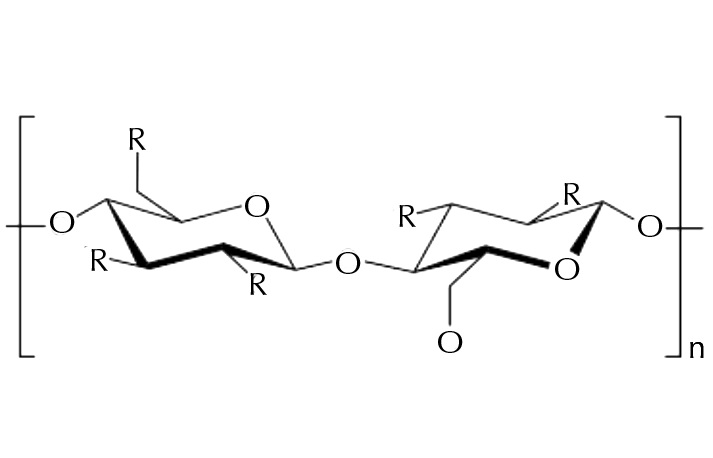What Is Hydroxyethylcellulose?
Hydroxyethylcellulose is an ingredient that you may not have heard of before. This is because hydroxyethylcellulose doesn’t convey any benefit to the skin but instead improves the texture and sensory feel of skincare formulations. Hydroxyethylcellulose is a cellulose-derived polymer that is used in cosmetics and skincare products as a thickening agent, that also works as a rheology modifier.
Hydroxyethylcellulose is a water-soluble polymer derived from cellulose. Cellulose is a natural sugar that is found in the cell wall of plants. In fact, cellulose is the most abundant organic sugar on Earth. While cellulose is naturally derived, hydroethylcellulose is synthetically made by reacting ethylene oxide with alkali-cellulose. Modified cellulose products such as hydroxyethylcellulose are widely used in skincare and cosmetic formulations and also find use in cleaning and household products. Additionally, hydroxyethylcellulose is commonly used in capsules for carrying medicines into the body and improving the drugs’ dissolution in the stomach.

Hydroxyethylcellulose
the good:Hyrdoxyethylcellulose is mainly used to help improve the texture and feel of skincare and cosmetic products.
the not so good:It doesn’t provide any other benefits to the skin in terms of improving the condition or appearance.
Who is it for?All skin types except those that have an identified allergy to it.
Synergetic ingredients:Works well with most ingredients
Keep an eye on: Be mindful that hydroxyethylcellulose is made by using 1,4-dioxane, a substance known to potentially contribute to some cancers. While the processes used to purify and subsequently remove all the 1,4 dioxane have been improved, it is often a source of controversy around this and other ingredients that use this ingredient in the manufacturing process.
Why Is Hydroxyethylcellulose Used In Skincare?
In cosmetics and skincare products, hydroxyethylcellulose functions to improve the texture and feel of formulations.
Thickener
Thickening agents are an important part of cosmetic formulation. They not only help to improve the feel of a product but also ensure the product spreads evenly and smoothly across the skin. This is particularly important when the skin is flaky or has an uneven complexion. There are more than 500 thickeners are used in skincare formulating due to their importance in the formulating process.
Cellulose derivatives are popular water-based thickeners. Hydroxyethylcellulose has the ability to thicken the water-based ingredients in the formulation. Dry hydroxyethylcellulose exists as white, free-flowing granular powder when water is added to hydroxyethylcellulose it causes the powder to swell into a crystal clear gel. In fact, of all the natural polymers, hydroxyethylcellulose creates the clearest serums and gels.
Rheology modifier
Hydroxyethylcellulose is also considered to be a rheology modifier. Rheology can be defined as “the science or study of how things flow”, and it is a requirement of skincare products that they flow in the right way. For example, a skin cream should have a rich, thick appearance in the jar, but should be capable of being easily picked up and spread into the skin. Rheology modifiers can be added to a formulation to adjust the product flow.
Often, the term ‘rheology modifier’ is used interchangeably with ‘thickener’. While increasing the apparent thickness will produce a feeling of ‘quality’ to the formulation, this is only one aspect of rheological control. For instance, hydroxyethylcellulose not only adds thickness to creams and lotions but also gives them a softer feel.
In shampoos and cleansers, hydroxyethylcellulose enhances foam creaminess and richness. This allows the manufacturer to use less surfactant or detergents while also reducing the irritation potential, thus making the cleanser more gentle and effective. Lastly, hydroxyethylcellulose is an excellent choice for clear hair gel where it will offer soft hold and a nice feel on the hair without stickiness or flaking.
What Are The Issues With Hydroxyethylcellulose?
There is one potential safety concern with hydroxyethylcellulose: contamination with 1,4-dioxane, a substance known to potentially contribute to some cancers. Hydroxyethylcellulose is made by reacting ethylene oxide with alkali-cellulose, a process known as ethoxylation. Ethoxylation can create small amounts of 1,4-dioxane and leave residual ethylene oxide in the product. 1,4-dioxane is a known animal carcinogen that penetrates readily into the skin. 1,4-dioxane has also been linked with skin allergies and is a kidney toxin, neurotoxin, and a respiratory toxin.
Despite these concerns, the potential presence of 1,4-dioxane can be controlled through purification steps to remove it before blending hydroxyethylcellulose into cosmetic formulations. This purification process is highly effective and prevents the presence of 1,4-dioxane in formulations.
Is Hydroxyethylcellulose Safe?
The safety of hydroxyethylcellulose has been assessed by the Cosmetic Ingredient Review Expert Panel, a group that is responsible for reviewing the safety of cosmetic and skincare ingredients. The Expert Panel evaluated the scientific data and concluded that this ingredient was safe as used in cosmetics and skincare products.
References: Cosmetic Ingredient Review, 1986. ‘Final Report on the Safety Assessment of Hydroxyethyl cellulose, HydroxypropyIcelIulose, Methylcellulose, Hydroxypropyl Methylcellulose, and Cellulose Gum, Journal of the American College of Toxicology. Bîrsan, M, Apostu, M, Todoran, N, Antonoaea, P, Rusu, A, & Ciurba, A, 2018. ‘Development of Dermal Films Containing Miconazole Nitrate’ Molecules, vol. 23, is. 7, 1640.







